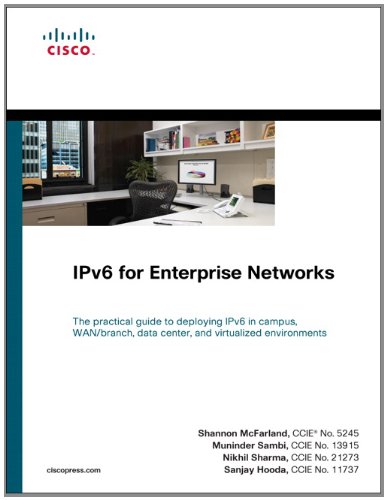Product desciption
Ipv6 For Enterprise Networks 1st Edition Shannon Mcfarland Muninder Sambi by Shannon Mcfarland, Muninder Sambi, Nikhil Sharma, Sanja Hooda 1587142279 instant download after payment.
IPv6 for Enterprise Networks The practical guide to deploying IPv6 in campus, WAN/branch, data center, and virtualized environments Shannon McFarland, CCIE® No. 5245 Muninder Sambi, CCIE No. 13915 Nikhil Sharma, CCIE No. 21273 Sanjay Hooda, CCIE No. 11737 IPv6 for Enterprise Networks brings together all the information you need to successfully deploy IPv6 in any campus, WAN/branch, data center, or virtualized environment. Four leading Cisco IPv6 experts present a practical approach to organizing and executing your large-scale IPv6 implementation. They show how IPv6 affects existing network designs, describe common IPv4/IPv6 coexistence mechanisms, guide you in planning, and present validated configuration examples for building labs, pilots, and production networks. The authors first review some of the drivers behind the acceleration of IPv6 deployment in the enterprise. Next, they introduce powerful new IPv6 services for routing, QoS, multicast, and management, comparing them with familiar IPv4 features and behavior. Finally, they translate IPv6 concepts into usable configurations. Up-to-date and practical, IPv6 for Enterprise Networks is an indispensable resource for every network engineer, architect, manager, and consultant who must evaluate, plan, migrate to, or manage IPv6 networks. Shannon McFarland, CCIE No. 5245, is a Corporate Consulting Engineer for Cisco serving as a technical consultant for enterprise IPv6 deployment and data center design with a focus on application deployment and virtual desktop infrastructure. For more than 16 years, he has worked on large-scale enterprise campus, WAN/branch, and data center network design and optimization. For more than a decade, he has spoken at IPv6 events worldwide, including Cisco Live. Muninder Sambi, CCIE No. 13915, is a Product Line Manager for Cisco Catalyst 4500/4900 series platform, is a core member of the Cisco IPv6 development council, and a key participant in IETF’s IPv6 areas of focus. Nikhil Sharma, CCIE No. 21273, is a Technical Marketing Engineer at Cisco Systems where he is responsible for defining new features for both hardware and software for the Catalyst 4500 product line. Sanjay Hooda, CCIE No. 11737, a Technical Leader at Cisco, works with embedded systems, and helps to define new product architectures. His current areas of focus include high availability and messaging in large-scale distributed switching systems. n Identify how IPv6 affects enterprises n Understand IPv6 services and the IPv6 features that make them possible n Review the most common tranisition mechanisms including dual-stack (IPv4/IPv6) networks, IPv6 over IPv4 tunnels, and IPv6 over MPLS n Create IPv6 network designs that reflect proven principles of modularity, hierarchy, and resiliency n Select the best implementation options for your organization n Build IPv6 lab environments n Configure IPv6 step-by-step in campus, WAN/branch, and data center networks n Integrate production-quality IPv6 services into IPv4 networks n Implement virtualized IPv6 networks n Deploy IPv6 for remote access n Manage IPv6 networks efficiently and cost-effectively This book is part of the Networking Technology Series from Cisco Press®, which offers networking professionals valuable information for constructing efficient networks, understanding new technologies, and building successful careers.


